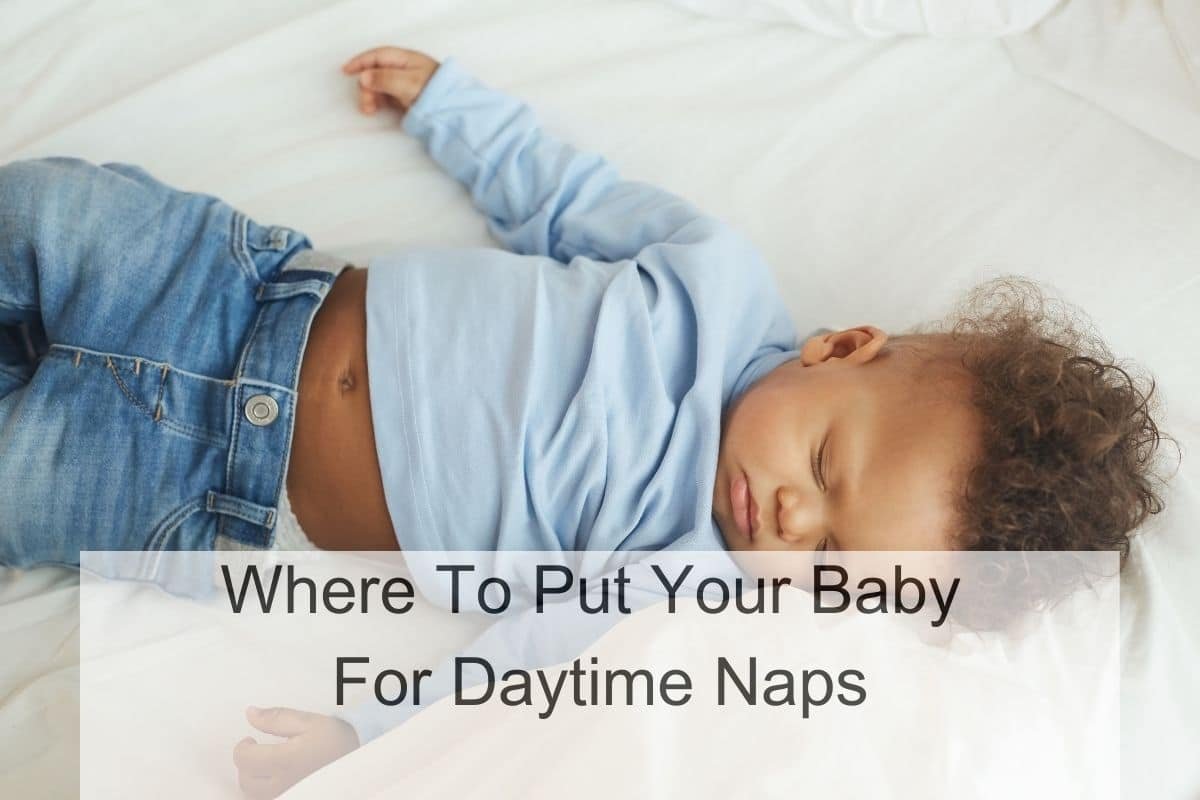When it comes to putting your baby down for a nap during the day, there are a few key things to consider. As a new parent, you may be wondering where the best place is for your baby to nap. While there are many options, it’s important to choose a safe and comfortable spot that will help your baby rest and recharge.

One option for daytime naps is to have your baby sleep in their crib or bassinet in their own room. This can help create a consistent sleep environment for your baby and make it easier for them to fall asleep on their own. However, it’s important to make sure that the room is cool, quiet, and free from distractions. Additionally, it’s important to follow safe sleep guidelines and always put your baby to sleep on their back to reduce the risk of Sudden Infant Death Syndrome (SIDS) Mayo Clinic.
Another option for daytime naps is to have your baby sleep in a portable crib or playpen in the same room as you. This can be a convenient option if you want to keep an eye on your baby while they nap. However, it’s important to make sure that the crib or playpen is set up properly and that your baby is always supervised while they sleep. Additionally, it’s important to avoid placing any soft bedding or toys in the crib or playpen, as these can increase the risk of suffocation What to Expect.
Understanding Baby’s Nap Needs

As a new parent, it can be challenging to understand your baby’s nap needs. However, recognizing your baby’s sleep cues and establishing a nap routine can make things easier.
Recognizing Sleep Cues
Babies have different sleep cues, and it’s essential to recognize them to ensure that your baby gets enough sleep. Some common sleep cues include rubbing eyes, yawning, and fussing. When you notice these signs, it’s time to put your baby down for a nap.
It’s also important to note that babies have different sleep needs at different ages. For instance, newborns sleep for about 16 hours a day, while older babies sleep for about 14 hours a day. Understanding your baby’s sleep needs will help you determine the right nap routine.
Establishing a Nap Routine
Establishing a nap routine is crucial for your baby’s sleep needs. A consistent nap routine helps your baby fall asleep faster and stay asleep longer.
One way to establish a nap routine is to create a sleep-friendly environment. Ensure that the room is dark, quiet, and cool. You can also use white noise machines to block out any external noise.
Another way to establish a nap routine is to follow a consistent schedule. Try to schedule your baby’s naps at the same time every day. This consistency helps your baby’s internal clock to adjust, making it easier for them to fall asleep.
Creating a Safe Sleep Environment

As a new parent, creating a safe sleep environment for your baby is a top priority. Here are some tips to help ensure your baby’s safety during daytime naps.
Choosing the Right Crib
When it comes to choosing a crib for your baby, safety should be your top concern. Look for a crib that meets the safety standards set by the Consumer Product Safety Commission (CPSC). Make sure the slats are no more than 2 3/8 inches apart to prevent your baby from getting stuck between them. The mattress should fit snugly in the crib, with no gaps between the mattress and the sides of the crib. Also, avoid using any loose bedding, such as blankets or pillows, which can increase the risk of suffocation.
Optimal Room Conditions
Creating the right environment in your baby’s room can also help promote safe sleep. Keep the room at a comfortable temperature, between 68 and 72 degrees Fahrenheit. Use blackout shades or curtains to block out any light that might interfere with your baby’s sleep. A white noise machine or fan can also help create a soothing environment for your baby.
Nap Scheduling Strategies

As a new parent, figuring out how to schedule your baby’s naps can be a daunting task. Here are some strategies that have worked for me:
Age-Appropriate Nap Times
Babies need a lot of sleep, but the amount and timing of their naps changes as they grow. According to the Mayo Clinic source, newborns sleep around 16 hours per day, while 6-9 month-olds need around 13-15.5 hours of sleep per day. As your baby grows, their nap times will change too. It’s important to keep an eye on their sleep cues and adjust their nap times accordingly.
Consistency and Flexibility
Consistency is key when it comes to nap scheduling. Babies thrive on routine, so try to stick to a consistent nap schedule as much as possible. However, it’s also important to be flexible. Sometimes your baby may need to nap earlier or later than usual, or they may need an extra nap. It’s okay to adjust their schedule as needed to accommodate their needs.
To make nap scheduling easier, consider using a nap tracking app or keeping a written log of your baby’s sleep patterns. This can help you identify their natural sleep patterns and adjust their nap schedule accordingly. Remember, every baby is different, so what works for one may not work for another. Be patient and keep experimenting until you find a nap schedule that works for both you and your baby.
Soothing Techniques for Easier Naps

As a new parent, you may find it challenging to put your baby down for a daytime nap. Fortunately, there are several soothing techniques that you can use to help your little one drift off to sleep. Here are a few techniques that have worked for me:
Swaddling
Swaddling is a technique where you wrap your baby snugly in a blanket to mimic the feeling of being in the womb. This can help your baby feel secure and calm, making it easier for them to fall asleep. To swaddle your baby, lay a blanket flat on the bed with one corner folded down. Place your baby on their back with their head on the folded corner. Wrap one side of the blanket snugly across your baby’s chest and tuck it under their opposite arm. Then, bring the bottom of the blanket up over your baby’s feet and tuck it in. Finally, wrap the remaining side of the blanket across your baby’s chest and tuck it under their opposite arm.
White Noise and Calm Music
White noise and calm music can help drown out other noises in the house and create a soothing environment for your baby. You can use a white noise machine or play calming music on a low volume. Some babies prefer white noise that sounds like the whooshing sound of the womb, while others prefer gentle lullabies. Experiment with different types of sounds to see what works best for your baby.
Monitoring and Adjusting Nap Practices
As a new parent, I quickly realized that my baby’s sleep patterns were constantly changing. It’s important to observe your baby’s sleep patterns to ensure they are getting the rest they need. Here are some tips to help you monitor and adjust your baby’s nap practices.
Observing Sleep Patterns
I found it helpful to keep a sleep log to track my baby’s sleep patterns. This helped me identify when my baby was tired and ready for a nap. Signs that your baby is ready for a nap may include rubbing their eyes, yawning, or becoming fussy. By observing your baby’s sleep patterns, you can adjust their nap schedule accordingly.
Adapting to Developmental Changes
As your baby grows and develops, their sleep needs will also change. It’s important to adapt to these changes and adjust your baby’s nap schedule accordingly. For example, as your baby starts to transition from two naps to one nap, you may need to adjust the timing of their nap to ensure they are getting enough rest.
Dealing with Common Naptime Challenges
As a new parent, I have experienced some common naptime challenges with my baby. Here are some tips that have helped me deal with them.
Short Naps
If your baby is taking short naps, try to extend the nap time by 10-15 minutes. You can do this by gradually delaying the time you go in to get your baby up from their nap. Another option is to try to soothe your baby back to sleep if they wake up too early. You can try gently patting their back or shushing them to help them fall back asleep.
Nap Resistance
If your baby is resisting nap time, try to establish a consistent nap routine. This can include a pre-nap ritual, such as reading a book or singing a lullaby, to help your baby wind down and get ready for sleep. Also, make sure your baby is well-fed and comfortable before nap time. If your baby is still resisting nap time, you can try shortening the awake time between naps to help them get the sleep they need.
When to Seek Professional Advice
As a parent, it’s natural to want to take care of your baby on your own. However, there may be times when it’s necessary to seek professional advice. Here are some situations where it’s a good idea to consult with a pediatrician or a sleep specialist:
- Persistent sleep problems: If your baby is consistently having trouble falling asleep or staying asleep, it’s important to get professional help. A sleep specialist can help you identify the underlying cause of the problem and suggest solutions.
- Excessive daytime sleepiness: If your baby is sleeping too much during the day and seems excessively sleepy, it may be a sign of a sleep disorder. A pediatrician can help you determine if there is an underlying medical condition that needs to be treated.
- Sudden changes in sleep patterns: If your baby’s sleep patterns suddenly change, it may be a sign of an underlying medical condition or developmental milestone. A pediatrician can help you determine if there is a problem that needs to be addressed.

